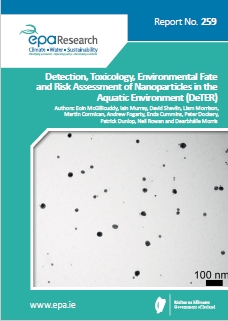Authors: Eoin McGillicuddy, Iain Murray, David Shevlin, Liam Morrison, Martin Cormican, Andrew Fogarty, Enda Cummins, Peter Dockery, Patrick Dunlop, Neil Rowan and Dearbháile Morris
Summary: Nanotechnology is an emerging technology that has the potential to impact on all aspects of life and the economy and is expected to form the basis of several technological innovations and advances in the 21st century.

This report demonstrates that, to date, the concentrations of silver nanoparticles in the aquatic environment have primarily been estimated through modelling, largely because of a dearth of appropriate detection methods, with predicted environmental concentrations in the ng/l range. This report also identifies that research is urgently required to determine the full extent of nanomaterial use and production in Ireland across all sectors in order to develop appropriate risk assessment and risk management policies and guidelines.
This research informs the development of policies on the regulation and standardisation of nanomaterials by building capacity in the area of the environment and health. It informs the following national regulations and EU directives with regard to engineered nanomaterials: the Water Framework Directive (2000), the Groundwater Directive (2006), Good Agricultural Practice for Protection of Waters (2010), the Environmental Quality Standards Directive (2008), the Floods Directive (2007), the Marine Strategy Framework Directive (2008), the Urban Waste Water Directive (1991), the Nitrates Directive (1991), the Bathing Water Directive (2006), the Drinking Water Directive (1998), the Biocidal Products Directive
(1998), the Biocidal Products Regulation (2012), the framework regulation on food contact materials and articles (FCM Regulation) (2004), the regulation on active and intelligent food contact materials (AIM Regulation) (2009) and the regulation on plastic materials and articles intended to come into contact with food (PIM Regulation) (2011).
This research demonstrates that activated charcoal represents a cost-effective material for the remediation of waters impacted by silver nanoparticles or other nano-waste. It provides valuable evidence that EDTA-free media should be used to improve toxicity test sensitivities. This research reveals that the concentrations of silver nanoparticles used in the model developed were at levels deemed unlikely to have toxicity concerns to aquatic organisms and, for the scenarios considered, there is no existing risk from silver nanoparticle residues following the consumption of drinking water.
https://www.epa.ie/media/epa-2020/publications/research/Research_259_Thumbnail[1].jpg